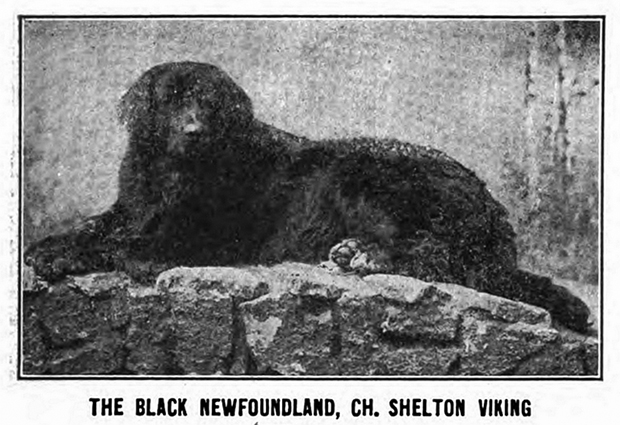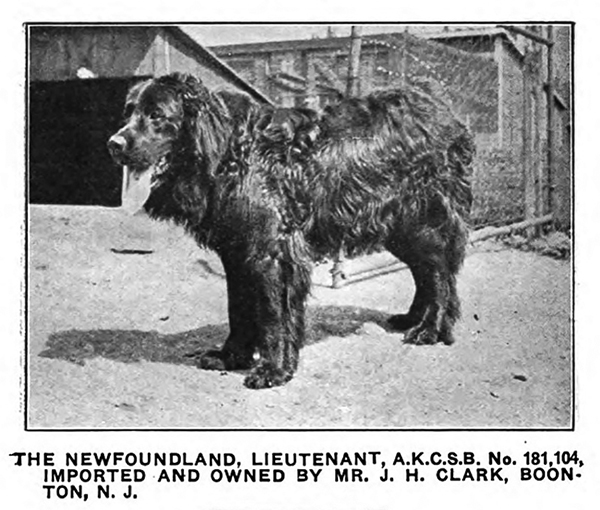[ C. S. R. Blue Book of Dogdom ]
The full title — or perhaps "more formal title" is the better phrase — of this work is Annual Directory of Breeders and Exhibitors of Dogs in the United States and Canada. The "C. S. R." in the common title comes from the fact it was published by the Common Sense Remedy Company of New York; it got the "Blue Book" name because it was originally published with blue covers.
At any rate, the first annual directory was published in 1909; it appears to me that the final edition was published in 1917. Text below is taken from the 1910 issue unless otherwise noted; the 1909 issue carried no breed descriptions or other sorts of breed-specific information aside from kennel listings.
The stated purpose of this annual was to provide, in response to "increasing interest in dogs and their breeders," an annual directory of breeders as well as a list of past shows and their judges, along with other information related to dog shows and dog breeds. That other information sometimes included brief breed descriptions.
The first mention of Newfoundlands was in the description of St. Bernards:
The St. Bernard, or the "Saintly" breed, share with the Newfoundland the credit of being the only two breeds of dogs whose mission and charac- teristics are the saving of life. . . . In general appearance the St. Bernard is an extremely large and powerful dog, with a beautiful head and speaking countenance, in which sagacity is blended with nobility, and a body of great symmetry, combining the agility of the Newfoundland with the strength of the Mastiff. (45)
The entry for the Newfoundland is preceeded by the following image of CH. Shelton Viking, who is mentioned and/or shown in other dog publications of the era, including in James Watson's 1905 The Dog Book and in the July, 1915, issue of The Dog Fancier where a photo of one of his get is used as an illustration of the breed standard:

One of the noblest breeds of the canine race, and it is to be deeply regretted that there are but very few specimens seen nowadays. The Newfoundland had its origin in the island at the mouth of the St. Lawrence, and were very serviceable in all the fishing plantations. They became quite popular for a time in England, but the classes at the shows have been growing smaller and smaller until at the present time it is a rarity to see a good specimen either in England or America. In general appearance the true Newfoundland is a large jet-black dog, with a long, straight coat and bushy tail, with a face extremely expressive and eyes that beam with intelligence. The head should be large and massive, broad and flat on top between the ears. The brow broad and the muscles between the eyes strongly developed. The muzzle deep, broad, moderately long and almost square at the end. Lips not tight, and the upper lips hanging slightly over the under, hiding a mouth of teeth of strength and powerful jaws. Eyes small, moderately well set in the head, and of dark hazel color or golden yellow. Ears small and placed high, and when in attention carried well forward. The body is a combination of strength and agility; neck moderately long, broadening toward the body, with the backbone long and strong; chest ample deep and wide; the loins particularly firm and strong; legs straight and on a line with the backbone. Feet as large as possible without being splayed, with well-padded soles under them. The face and portion of the ears should be covered with short, soft hair, and also for the front part of the legs, both fore and hind, but everywhere else on the body the coat must be very massive. It lengthens out after you pass the occiput, lumped on the shoulders, forming a heavy mane. The feathering goes down the afterpart of the legs as far as the toes and forms a splendid fringe on the fore ones. The tail is also flagged. The coat in texture should resemble that of the Collie. The tail should be long and strong and carried well down. The color is black all over, except a star of white on the chest. In size from twenty-seven inches at the shoulders and upwards. As a domestic pet the Newfoundland is the greatest favorite.
There are two other mentions of Newfs: the entry on "The Retriever" notes in passing that "The Labrador Retriever had its common origin with the Newfoundland...." (53); and the Glossary, as its definition of "Lengthy," offers "Possessing length of body, as the Newfoundland ought to do"
The Newfoundland breed description was not repeated in the 1911 or 1912 editions; the above text and photo were repeated verbatim in the 1914 edition. (I have not been able to find an online version of the 1913 and 1915 editions [vols. 5 and 7]).
The 1916 issue featured a change both of the photo and the text. The photo was of a Newfoundland mentioned several times in contemporary issues of various dog magazines, a dog named Lieutenant who belonged to the Newf fancier and breeder Josiah H. Clark, whose "Clark Farm Kennel" is also mentioned as one of the two Newfoundland breeders in this edition's kennel listing.
The text for the Newfoundland section was the official Kennel Club breed standard:
Symmetry and General Appearance. – The dog should impress the eye with strength and great activity. He should move freely on his legs, with the body swung loosely between them, so that a slight roll in gait should not be objectionable; but at the same time a weak or hollow back, slackness of the loins, or cowhocks should be a decided fault.
Head, – Should be broad and massive, flat on the skull, the occipital bone well developed; there should be no decided stop, and the muzzle should be short, clean cut, rather square in shape, and covered with short fine hair.
Coat. — Should be flat and dense, of a coarsish texture and oily nature, and capable of resisting the water. If brushed the wrong way, it should fall back into its place naturally.
Body. — Should be well ribbed up, with a broad back. A neck strong, well set on to the shoulders and back, and strong muscular loins.
Fore Legs. — Should be perfectly straight, well covered with muscle, elbows in but well let down, and feathered all down.
Hindquarters and Legs. — Should be very strong; the legs should have great freedom of action, and a little feather. Slackness of loins and cowhock are a great defect; dew-claws are objectionable, and should be removed.
Chest. — Should be deep and fairly broad and well covered with hair, but not to such an extent as to form a frill.
Bone. - Massive throughout, but not to give a heavy, inactive appearance.
Feet. — Should be large and well shaped. Splayed or turned-out feet are objectionable.
Tail. — Should be of moderate length, reaching down a little below the hocks; it should be of fair thickness and well covered with long hair, but not to form a flag. When the dog is standing still and not excited, it should hang downwards, with a slight curve at the end ; but when the dog is in motion, it should be carried a trifle up, and when he is excited, straight out, with a slight curve at the end. Tails with a kink in them, or curled over the back, are very objectionable.
Ears. — Should be small, set well back, square with the skull, lie close to the head, and covered with short hair, and no fringe.
Eyes. — Should be small, of a dark brown colour, rather deeply set, but not showing any haw, and they should be rather widely apart.
Colour. — Dull jet black. A slight tinge of bronze, or a splash of white on chest and toes is not objectionable.
Height and Weight. — Size and weight are very desirable so long as symmetry is maintained. A fair average height at the shoulders is 28in. for a dog and 26in. for a bitch, and a fair average weight is respectively: dogs, 140lb. to 150lb.; bitches, 110lb. to 120lb.
Other than Black. — Should in all respects follow the black except in colour, which may be almost any, so long as it disqualifies for the Black class, but the colours most to be encouraged are black-and-white and bronze. Beauty in markings to be taken greatly into consideration.
Dogs that have been entered in Black classes at shows held under Kennel Club rules, where classes are provided for dogs other than black, shall not be qualified to compete in other than black classes in future.
Black dogs that have only white toes and white breasts and white tip to tail, should be exhibited in the classes provided for "black."
The scale of points are:
Head 34 points:
Shape of Skull........................................ 8
Ears....................................................... 10
Eyes...................................................... 8
Muzzle.................................................... 8
Body: 66 points:
Neck........................................................ 4
Chest....................................................... 6
Shoulders................................................ 4
Loin and Back...................................... 12
Hindquarters and Tail........................... 10
Legs and Feet........................................ 10
Coat...................................................... 12
Size, Height, and General Appearance... 8
___
Total points in all............................... 100
The only other mentions of Newfoundlands in this issue are the reference to them in the Labrador breed discussion (see above) and a few listings of imported Newfs in the "Leading Events of the Year" section.
The text and photo from the 1916 were repeated verbatim in 1917, which I believe may have been the final year of publication of the Blue Book of Dogdom.


